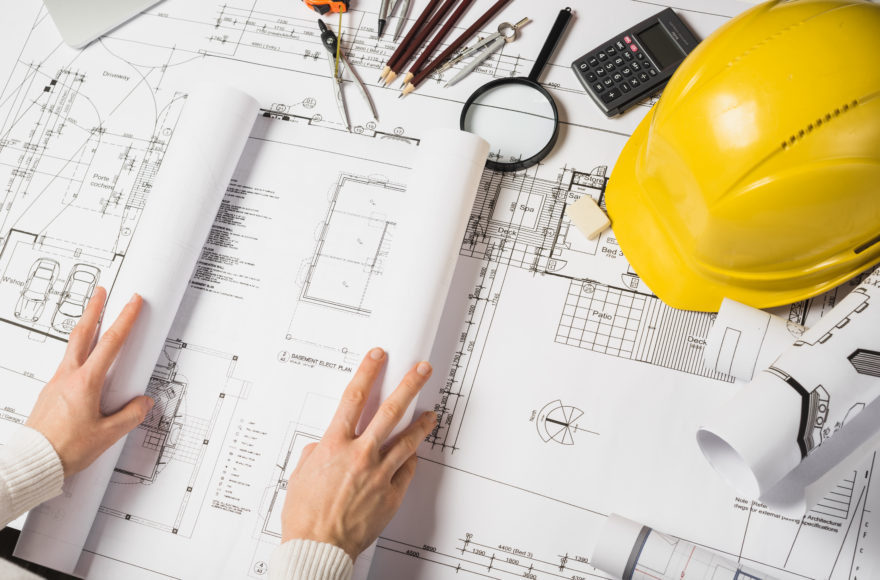7 Construction Industry Trends to Look Forward in 2021

The covid-19 pandemic has led to unprecedented fallout in several industries, and the construction industry trends are not an exception. The lockdown days have changed how the construction industry carries out its projects, and construction business owners face several challenges in the industry.
FMI Corporation’s quarterly issue states that the construction industry lags a general recession by 12 to 18 months. The industry professionals and workers are already striving hard to transform the sector by accelerating technology adoption.
The innovative technologies in construction are changing the functionality of the industry, and the workers need to adapt themselves to these changes so that they can be diligent in strengthening the sector. In this article, we have listed the ten construction industry trends to look out for in 2021.
1) Building Information Modelling (BIM)
Building Information Modelling acts as the basis of digital transformation in the field of construction. Construction designers find it easy and challenging to construct their building model in a virtual environment before building it in real life.
BIM allows designers to create computerized buildings and utilities. It also helps the estimators by providing them with the exact quantities of building materials needed for a project. This technology allows users to share the data with their peer groups to complete the tasks faster, thus leading to a collaborative workspace.
Some of the BIM software available are Autodesk BIM 360, BIMobject, BIMx, Revit, and Navisworks.
2) Internet Of Things(IoT)
Technology evolution has benefitted most of us, and one such technology is the Internet of Things, which links all the technological devices together. IoT has ensured safety for construction workers in different ways.
IoT helps in reducing accidents that might happen in the sites. Sensors fixed on workers’ clothing, hardhats, and other wearables can monitor and alert them to any danger on the construction site and prevent them from entering unsafe areas.
Construction sites are connected by sensors, CCTV cameras, and drones that send real-time reporting data to a central office where the construction project owners make decisions. Wearable technologies also alert the workers when they are near each other, thus helping them maintain social distancing.
3) Artificial Intelligence and Machine Learning
AI enables computers and machines to impersonate the behavior of humans. Machine learning uses algorithms to learn from data and patterns provided to them and make decisions without human intervention.
Construction industries have already started using artificial intelligence on their sites for performing tasks like bricklaying, pouring concrete, and welding autonomously.
The construction field often involves several time-consuming tasks like project management, task assignment, and keeping track of the employees. Artificial intelligence can perform these tasks effectively with few or zero errors.
AI has the potential to assign tasks autonomously based on the employees’ experience, skills, and availability. Artificial intelligence also increases the productivity of employees and assures safety in the workplace.
4) Drones and Robots
Construction owners are using drones as a monitoring tool to check the progress of their site project. The cameras, laser scanners, and data collection devices in the drones capture photos and videos of the construction site. They are then processed through photogrammetry software to create orthophotos, digital elevation models (DEMs), and 3D point clouds, thus helping the project managers to increase their projects’ overall efficiency.
Robots assist construction workers in performing tasks like laying bricks, tying rebar, and installing drywall. Mostly, construction robots don’t replace workers but increase their performance and help them be more productive.
5) Virtual Reality and Augmented Reality
We must have heard about virtual and augmented reality used in the gaming industry, and these technologies are now gaining popularity in the construction sector. New construction workers need practice with heavy equipment, but it is not safe to train them on actual equipment. Virtual reality training simulators allow trainees to feel that heavy equipment virtually in a safe and highly controlled environment.
VR also works in combination with Building Information Modeling (BIM). Construction designers create the building design with BIM and then use VR to walk around the building virtually. It provides the client with more realistic aspects of how the building looks once the project gets completed.
6) 3D Printing
3D printing technology reduces the production time of building materials for the construction project. Materials can be printed and then transported to the construction site to use immediately, thus increasing the speed of the construction process.
It is a fully automated technology that can reduce human error. 3D printers are programmed to perform the construction process, and there is no need for any additional material. 3D printers can recycle waste materials, thus saving a lot of production costs spent on material waste. Some of the 3D printing technologies used in the construction industry include robotic arm extruders and sand 3D printing.
7) Prefab, Modular and Offsite Construction
Modular construction and prefab building are highly developing technologies in the construction industry trends. Modular construction is the process of constructing the building offsite using the same materials under controlled plant conditions. Buildings are produced in modules in airy buildings, with plenty of room for distancing.
These modules are then transported from the manufacturing unit to the installation site with the help of ceiling cranes, conveyors, and lifts. This process reduces labor cost, material waste and provides greater flexibility. Offsite construction is less time-consuming, safe, sustainable, and cost-efficient.
Final Thoughts
The pandemic has pushed the construction industry owners and stakeholders to adopt more technological options at a higher level. Technology in construction is vital industry trends to improve the productivity of construction workers, increase safety and recover from the aftereffects of the pandemic.



